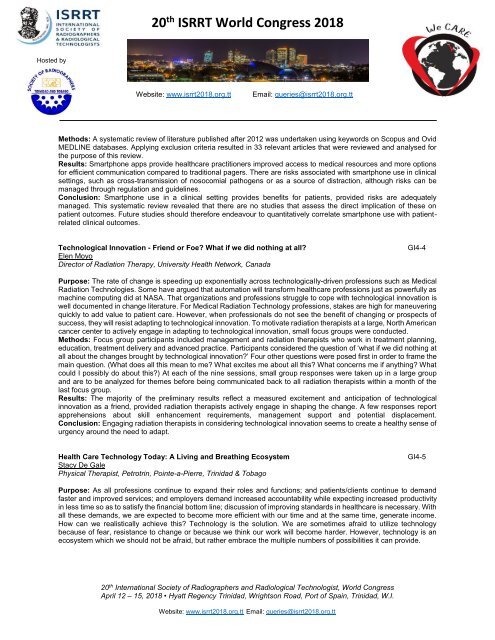Trinidad-and-Tabago-Congerss-Abstract-Book
Create successful ePaper yourself
Turn your PDF publications into a flip-book with our unique Google optimized e-Paper software.
20 th ISRRT World Congress 2018<br />
Hosted by<br />
Website: www.isrrt2018.org.tt<br />
Email: queries@isrrt2018.org.tt<br />
Methods: A systematic review of literature published after 2012 was undertaken using keywords on Scopus <strong>and</strong> Ovid<br />
MEDLINE databases. Applying exclusion criteria resulted in 33 relevant articles that were reviewed <strong>and</strong> analysed for<br />
the purpose of this review.<br />
Results: Smartphone apps provide healthcare practitioners improved access to medical resources <strong>and</strong> more options<br />
for efficient communication compared to traditional pagers. There are risks associated with smartphone use in clinical<br />
settings, such as cross-transmission of nosocomial pathogens or as a source of distraction, although risks can be<br />
managed through regulation <strong>and</strong> guidelines.<br />
Conclusion: Smartphone use in a clinical setting provides benefits for patients, provided risks are adequately<br />
managed. This systematic review revealed that there are no studies that assess the direct implication of these on<br />
patient outcomes. Future studies should therefore endeavour to quantitatively correlate smartphone use with patientrelated<br />
clinical outcomes.<br />
Technological Innovation - Friend or Foe? What if we did nothing at all?<br />
Elen Moyo<br />
Director of Radiation Therapy, University Health Network, Canada<br />
GI4-4<br />
Purpose: The rate of change is speeding up exponentially across technologically-driven professions such as Medical<br />
Radiation Technologies. Some have argued that automation will transform healthcare professions just as powerfully as<br />
machine computing did at NASA. That organizations <strong>and</strong> professions struggle to cope with technological innovation is<br />
well documented in change literature. For Medical Radiation Technology professions, stakes are high for maneuvering<br />
quickly to add value to patient care. However, when professionals do not see the benefit of changing or prospects of<br />
success, they will resist adapting to technological innovation. To motivate radiation therapists at a large, North American<br />
cancer center to actively engage in adapting to technological innovation, small focus groups were conducted.<br />
Methods: Focus group participants included management <strong>and</strong> radiation therapists who work in treatment planning,<br />
education, treatment delivery <strong>and</strong> advanced practice. Participants considered the question of ‘what if we did nothing at<br />
all about the changes brought by technological innovation?’ Four other questions were posed first in order to frame the<br />
main question. (What does all this mean to me? What excites me about all this? What concerns me if anything? What<br />
could I possibly do about this?) At each of the nine sessions, small group responses were taken up in a large group<br />
<strong>and</strong> are to be analyzed for themes before being communicated back to all radiation therapists within a month of the<br />
last focus group.<br />
Results: The majority of the preliminary results reflect a measured excitement <strong>and</strong> anticipation of technological<br />
innovation as a friend, provided radiation therapists actively engage in shaping the change. A few responses report<br />
apprehensions about skill enhancement requirements, management support <strong>and</strong> potential displacement.<br />
Conclusion: Engaging radiation therapists in considering technological innovation seems to create a healthy sense of<br />
urgency around the need to adapt.<br />
Health Care Technology Today: A Living <strong>and</strong> Breathing Ecosystem<br />
Stacy De Gale<br />
Physical Therapist, Petrotrin, Pointe-a-Pierre, <strong>Trinidad</strong> & Tobago<br />
GI4-5<br />
Purpose: As all professions continue to exp<strong>and</strong> their roles <strong>and</strong> functions; <strong>and</strong> patients/clients continue to dem<strong>and</strong><br />
faster <strong>and</strong> improved services; <strong>and</strong> employers dem<strong>and</strong> increased accountability while expecting increased productivity<br />
in less time so as to satisfy the financial bottom line; discussion of improving st<strong>and</strong>ards in healthcare is necessary. With<br />
all these dem<strong>and</strong>s, we are expected to become more efficient with our time <strong>and</strong> at the same time, generate income.<br />
How can we realistically achieve this? Technology is the solution. We are sometimes afraid to utilize technology<br />
because of fear, resistance to change or because we think our work will become harder. However, technology is an<br />
ecosystem which we should not be afraid, but rather embrace the multiple numbers of possibilities it can provide.<br />
20 th International Society of Radiographers <strong>and</strong> Radiological Technologist, World Congress<br />
April 12 – 15, 2018 • Hyatt Regency <strong>Trinidad</strong>, Wrightson Road, Port of Spain, <strong>Trinidad</strong>, W.I.<br />
Website: www.isrrt2018.org.tt Email: queries@isrrt2018.org.tt


















